Wildflowers of the Adirondacks:
Dutchman’s Breeches (Dicentra cucullaria)
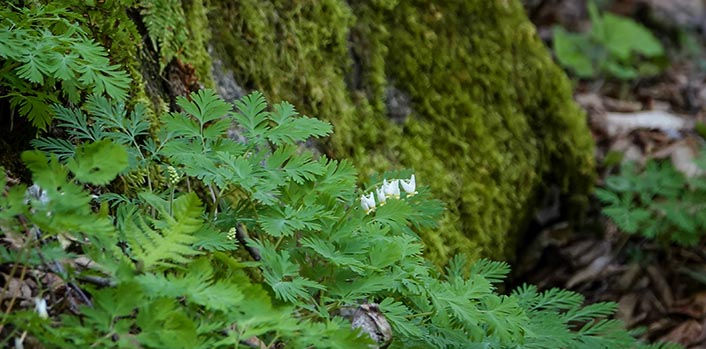
Dutchman’s Breeches (Dicentra cucullaria) is a low-growing spring ephemeral plant with feathery leaves. Its pantaloon-shaped white and yellow flowers appear in late April and early May in the Adirondacks.
Dutchman's Britches is a member of the Dicentra (Bleeding Heart) genus. The only other member of this genus that occurs in the Adirondack Park is Squirrel Corn (Dicentra canadensis). Both Dutchman's Breeches and Squirrel Corn are spring ephemerals.
- The genus name (dicentra) comes from the Greek word "dis," meaning twice, and "centon," meaning spur. This is a reference to the flower shape being "twice-spurred."
- The species name (cucullaria). meaning "hood-like," derives from the fact that the sides of the two spurs curve inward, resembling a hood.
The name Dutchman's Breeches is a reference to the fact that plant's flower cluster resembles a series of old-fashioned Dutchman's baggy breeches, hanging upside down on a clothes line to dry. Other nonscientific names for Dutchman's Breeches include Staggerweed and Little Blue Staggers. These names are derived from the plant's ability to induce drunken staggering in the cattle that graze on it.
Identification of Dutchman's Breeches
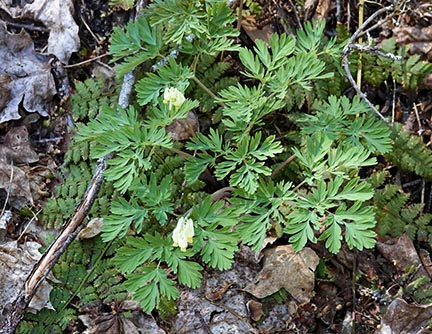
Dutchman's Breeches is a spring ephemeral – perennial woodland plants that sprout from the ground early each spring. All the above-ground action takes place between snow melt and full leaf-out of deciduous trees.
- Spring ephemerals quickly bloom and seed before the canopy trees overhead leaf out.
- Once the leaves of the canopy trees above have leafed out and the forest floor is deep in shade, the leaves of spring ephemerals wither away leaving just the roots, rhizomes, and bulbs underground.
This strategy allows Dutchman's Breeches and other spring ephemerals, like Carolina Springbeauty, Dwarf Ginseng, Trout Lily, and Squirrel Corn, to take advantage of the full sun hitting the forest floor early in the growing season.
Like the other spring peripherals found in the Adirondacks, Dutchman's Breeches are small plants, growing from four to eight inches tall. The plant grows from a cluster of pink to white teardrop-shaped bulblets.
The leaves of Dutchman's Breeches make the plant appear somewhat fern-like. The grayish-green leaves are three to six inches long. They are compound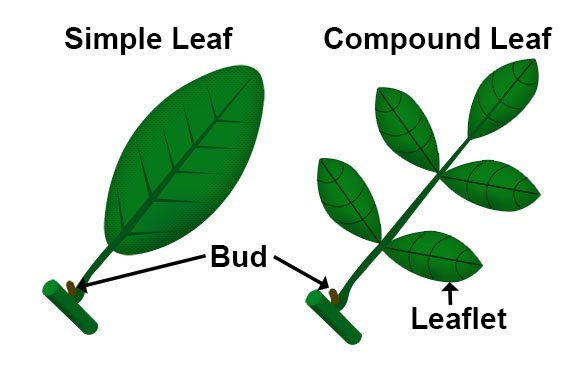 Compound Leaf: A leaf that is divided to the midrib, with distinct, expanded portions called leaflets., meaning that the leaves are composed of a number of leaflets. Each leaf is divided into three primary leaflets, which are in turn divided into three secondary leaflets which are cleft into lobes
Compound Leaf: A leaf that is divided to the midrib, with distinct, expanded portions called leaflets., meaning that the leaves are composed of a number of leaflets. Each leaf is divided into three primary leaflets, which are in turn divided into three secondary leaflets which are cleft into lobes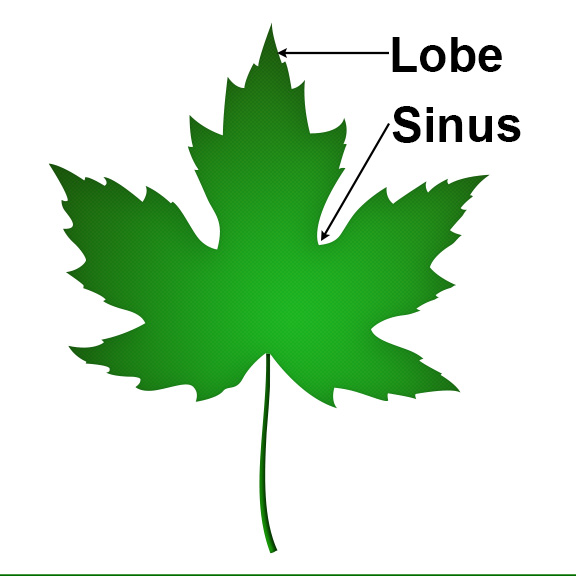 Lobe: A projection from an edge of a plant structure (such as a leaf), larger than a tooth. Lobed leaves are leaves with distinct protrusions, either rounded or pointed.. The leaves are basalBasal: Leaves are confined to the base of the stem. , meaning that the leaves grow only from the base of the plant; the leaves emerge on long, slender leaf stalks (petioles
Lobe: A projection from an edge of a plant structure (such as a leaf), larger than a tooth. Lobed leaves are leaves with distinct protrusions, either rounded or pointed.. The leaves are basalBasal: Leaves are confined to the base of the stem. , meaning that the leaves grow only from the base of the plant; the leaves emerge on long, slender leaf stalks (petioles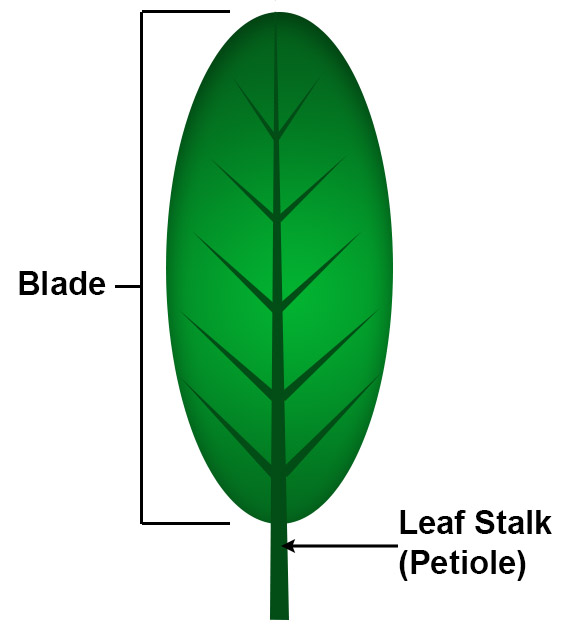 Petiole: The stalk that joins a leaf to a stem.). The leaves die back after the seed is formed.
Petiole: The stalk that joins a leaf to a stem.). The leaves die back after the seed is formed.
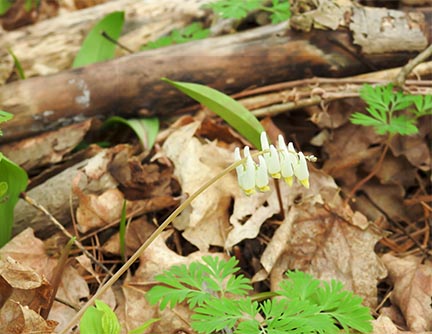
The flowers of Dutchman's Breeches are white (sometimes pinkish) with two pale yellow lobes at the base of the flower. The flowers hang in a terminal cluster (inflorescence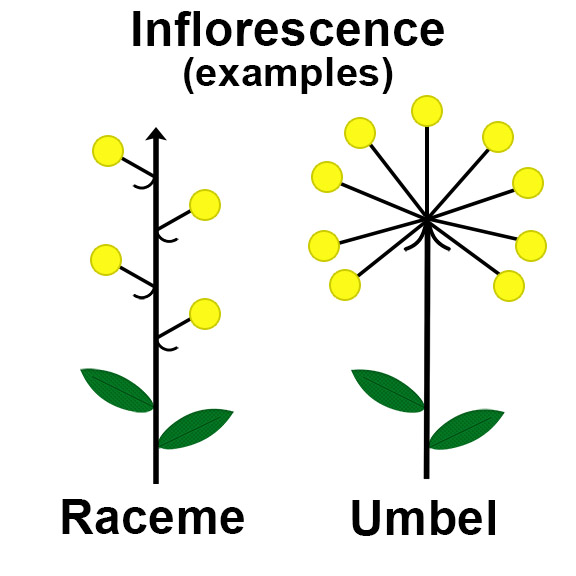 Inflorescence: A group or cluster of flowers arranged on a stem. ) that leans or arches over the leaves. The cluster consists of three to 14 individual flowers with pale red to yellowish stalks. The individual flowers are about ¾ inch long and assume the form of an upside-down Dutchman's Breeches. Each flower consists of two outer petals
Inflorescence: A group or cluster of flowers arranged on a stem. ) that leans or arches over the leaves. The cluster consists of three to 14 individual flowers with pale red to yellowish stalks. The individual flowers are about ¾ inch long and assume the form of an upside-down Dutchman's Breeches. Each flower consists of two outer petals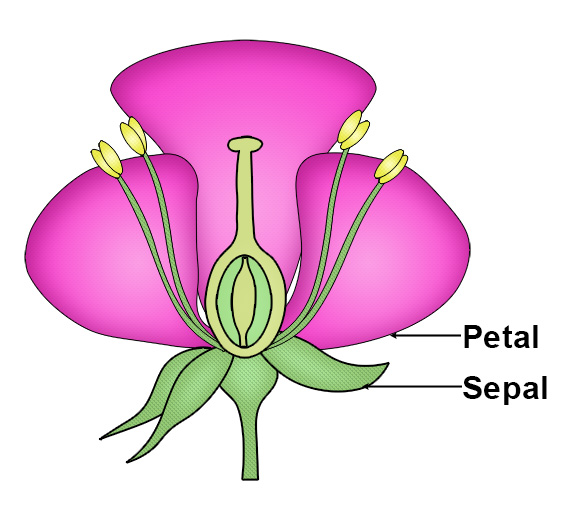 Petals: Modified leaves that surround the reproductive parts of flowers. Petals are often brightly colored or unusually shaped to attract pollinators. that are white and two smaller inner petals that are pale yellow. The flowers are adapted for pollination by bumblebees.
Petals: Modified leaves that surround the reproductive parts of flowers. Petals are often brightly colored or unusually shaped to attract pollinators. that are white and two smaller inner petals that are pale yellow. The flowers are adapted for pollination by bumblebees.
Dutchman's Breeches bloom from early to late spring. A tally for the upland Adirondack areas compiled by Michael Kudish, based on data collected from the early seventies to the early nineties, lists the median date for flower buds as 23 April, the earliest date for for flowers as 26 April, the median date for flowers as 5 May, and the latest date for flowers as 17 May. Observations of Dutchman's Breeches on iNaturalist suggest a similar pattern, with flowers observed in the warmer areas near Lake Champlain in late April and mid-May in the High Peaks region.
The flowers of Dutchman's Breeches are replaced by fruit, which develops quickly by the time the overarching trees have begun to leaf out. Kudish's compilation for the upland Adirondack region suggests an average date for fruiting as 29 May. The fruit is a slender pod about ¼ to ⅝ inches long, tapering to a point at both ends. The capsules eventually split apart to release the small, kidney-shaped seeds.
Dutchman's Breeches may be confused with a similar and closely-related species: Squirrel Corn (Dicentra canadensis). Both species are found in similar woodland habitats; and the leaves are quite similar.
- However, the leaves of Squirrel Corn are more finely dissected and slightly more blue-green-in color.
- Moreover, Squirrel Corn's flowers and heart-shaped and white, sometimes tinged with lavender; they lack the pantaloon shape of Dutchman's Breeches.
- In addition, Squirrel Corn flowers have a fragrance resembling hyacinths; the flowers of Dutchman's Breeches lack fragrance.
- Finally, Squirrel Corn's bulblets are yellow and resemble corn kernels, while those of Dutchman's Breeches are pink to white and teardrop-shaped.
Uses of Dutchman's Breeches
Dutchman's Breeches have very limited uses. All parts of the plant are said to contain high levels of toxic alkaloids. Contact with the plant may cause minor skin irritation, especially in cases of repeated contact with the cell sap. Cattle allowed to graze in areas where Dutchman's Breeches is present may suffer from breathing difficulties, convulsions, and even death as a result of consuming the leaves or the bulblets, which contain cucullarine.
Several Native American groups used the plant in the past for medicinal purposes. The Iroquois, for instance, reportedly used a compound infusion of the leaves as a liniment. The Menominee are said to have used it as a love charm.
Wildlife Value of Dutchman's Breeches
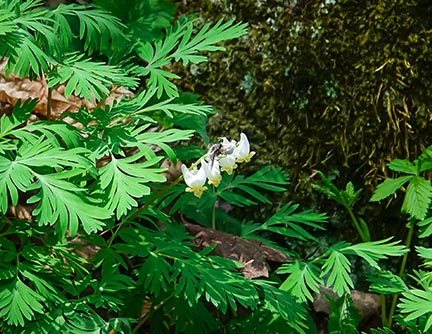
Dutchman's Breeches is of limited use to most wildlife. Although Woodland Voles reportedly eat the subterranean roots, tubers, and stems, most mammals avoid the plant.
Dutchman's Breeches are of greater use to certain insects. The nectar of the flowers attracts long-tongued bees, particularly bumble bees (including Bombus bimaculatus and Bombus affinis), and honey bees. Less common visitors include Greater Bee Flies, butterflies (such as Red Admirals and Cabbage Whites), and skippers.
Dutchman's Breeches, like Squirrel Corn, is dependent for pollination on queen bumble bees. The bees are attracted to the flowers by the contrasting white and yellow colors. The bees hang inverted from the flower and thrust their head into the opening between the outer and inner petals, extending the tongue to secure nectar in the spur. During this process, pollen is deposited on the bee's abdomen. When the bee visits another flower, the pollen is brushed off on the stigma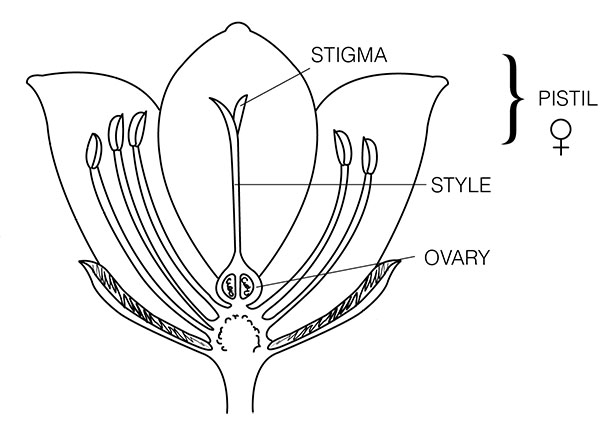 Stigma: part of the pistil, which is the seed-producing, or female, unit of a flower. The stigma is the tip of the pistil, where the pollen lands.. Although other insects (including butterflies and skippers) obtain nectar from Dutchman's Breeches flowers, they do so by biting a hole in the spur to get direct access and do not play a role in pollination.
Stigma: part of the pistil, which is the seed-producing, or female, unit of a flower. The stigma is the tip of the pistil, where the pollen lands.. Although other insects (including butterflies and skippers) obtain nectar from Dutchman's Breeches flowers, they do so by biting a hole in the spur to get direct access and do not play a role in pollination.
Dutchman's Breeches also provides nutrition for ants. The seeds of this plant, like many other plant species, have elaiosomes (fleshy or oil appendages), which are very nutritious and attractive to ants. The foraging ants carry the seeds back to their ant colonies and remove the elaiosomes to feed to their young. The seeds themselves are discarded in underground middens or ejected from the nest to develop into the next generation of plants.
Distribution of Dutchman's Breeches
Dutchman's Breeches occurs throughout the eastern United States and southern Canadian provinces, plus Washington, Idaho, and Oregon in the western United States. Within New York State, this plant is found in most counties, including all Adirondack Park counties except Fulton, Herkimer, and Oneida.
Habitat of Dutchman's Breeches
Throughout its range, Dutchman's Breeches grows in rich woods and shaded ledges. In the Adirondack Mountains, it occurs in well-drained northern hardwood forests, usually under Sugar Maple. It is found in several ecological communities including Maple-Basswood Rich Mesic Forest and Beech-Maple Mesic Forest.
The most likely place to find Dutchman's Breeches in the Adirondack Park is in a Maple-Basswood Rich Mesic Forest. This is a northern hardwood forest that typically occurs on well-drained, moist soils.
- The dominant trees are Sugar Maple and Basswood. Some Yellow Birch and American Beech can also be found here.
- In the understory, look for Alternate-leaved Dogwood, Mountain Maple, and Witch Hazel.
- The forest floor hosts a variety of early spring blooming species growing near Dutchman's Breeches, including Squirrel Corn, Carolina Springbeauty, Blue Cohosh, Early Blue Cohosh, Two-leaved Toothwort, Round-leaved Violet, and Bloodroot.
- Ferns found in this ecological community include Maidenhair Fern, Marginal Wood Fern, and Christmas Fern.
- Wildlife found in this community include mammals such as Black Bear and Eastern Chipmunk and amphibians such as Eastern Newt and Wood Frog. Characteristic birds include Black-throated Blue Warbler, Black-and-White Warbler, Ovenbird, and Scarlett Tanager.
References
Michael Kudish. Adirondack Upland Flora: An Ecological Perspective (The Chauncy Press, 1992), pp. 60, 111-112.
New York Flora Association. New York Flora Atlas. Dutchman’s Breeches. Dicentra cucullaria. Retrieved 19 April 2021.
Integrated Taxonomic Information System. Dicentra cucullaria. Retrieved 18 April 2021.
J. T. Kartesz. The Biota of North America Program (BONAP). 2015. Taxonomic Data Center. Chapel Hill, N.C. Dicentra cucullaria. Retrieved 19 April 2021.
United States Department of Agriculture. The Plants Database. Dutchman's Breeches. Dicentra cucullaria. Retrieved 19 April 2021.
United States Department of Agriculture. Forest Service. Plant of the Week. Dutchman’s Breeches. Dicentra cucullaria. Retrieved 19 April 2021.
Flora of North America. Dicentra cucullaria. Retrieved 19 April 2021.
NatureServe Explorer. Online Encyclopedia of Life. Dutchman's Breeches. Dicentra cucullaria. Retrieved 19 April 2021.
Margaret B. Gargiullo. A Guide to Native Plants of the New York City Region (New York City Department of Parks & Recreation, 2007), p. 88.
Native Plant Trust. Go Botany. Dutchman's-breeches. Dicentra cucullaria. Retrieved 19 April 2021.
New York State. Department of Environmental Conservation. New York Natural Heritage Program. Ecological Communities of New York State. Second Edition (March 2014), pp. 120-121 . Retrieved 17 October 2015.
New York Natural Heritage Program. 2021. Online Conservation Guide for Maple-Basswood Rich Mesic Forest. Retrieved 19 April 2021.
New York Natural Heritage Program. 2021. Online Conservation Guide for Beech-Maple Mesic Forest. Retrieved 19 April 2021.
Elizabeth H. Thompson and Eric R. Sorenson. Wetland, Woodland, Wildland: A Guide to the Natural Communities of Vermont (University Press of New England, 2000), pp. 136-144. Retrieved 23 April 2021.
New York State. Adirondack Park Agency. Preliminary List of Species Native Within the Adirondack Park Listed Alphabetically by Scientific Name and Sorted by Habit. Volume 1. Updated 10.23.2006, p. 20. Retrieved 26 January 2017.
USA National Phenology Network. Nature’s Notebook. Dicentra cucullaria. Retrieved 19 April 2021.
Connecticut Botanical Society. Dutchman's Breeches. Dicentra cucullaria. Retrieved 19 April 2021.
University of Wisconsin. Flora of Wisconsin. Dutchman's-breeches. Dicentra cucullaria. Retrieved 19 April 2021.
Minnesota Wildflowers. Dutchman's Breeches. Dicentra cucullaria. Retrieved 19 April 2021.
Illinois Wildflowers. Dutchman's Breeches. Dicentra cucullaria. Retrieved 19 April 2021.
Illinois Wildflowers. Vertebrate Animal & Plant Database. Dutchman's Breeches. Dicentra cucullaria. Retrieved 19 April 2021.
Illinois Wildflowers. Insect Visitors of Illinois Wildflowers. Dutchman's Breeches. Dicentra cucullaria. Retrieved 19 April 2021.
Eloise Butler Wildflower Garden. The Friends of the Wild Flower Garden. Dutchman's Breeches. Dicentra cucullaria. Retrieved 19 April 2021.
Lady Bird Johnson Wildflower Center. Dutchman's Breeches. Dicentra cucullaria. Retrieved 20 April 2021.
iNaturalist. Dutchman's Breeches. Dicentra cucullaria. Retrieved 20 April 2021.
iNaturalist. Adirondack Park Observations. Dutchman's Breeches. Dicentra cucullaria. Retrieved 20 April 2021.
Donald J. Leopold and Lytton John Musselman. Wildflowers of the Adirondacks (Johns Hopkins University Press, 2020), pp. 29, 276.
Anne McGrath. Wildflowers of the Adirondacks (EarthWords, 2000), p. 3, Plate 1.
Carol Gracie. Spring Wildflowers of the Northeast. A Natural History (Princeton University Press, 2012), pp. 42-49.
Roger Tory Peterson and Margaret McKenny. A Field Guide to Wildflowers. Northeastern and North-central North America (Houghton Mifflin Company, 1968), p. 72-73. Retrieved 20 April 2021.
Doug Ladd. North Woods Wildflowers (Falcon Publishing, 2001), p. 189.
Lawrence Newcomb. Newcomb's Wildflower Guide (Little Brown and Company, 1977), pp.34-35.
David M. Brandenburg. Field Guide to Wildflowers of North America (Sterling Publishing Company, Inc., 2010), p. 251.
Timothy Coffey. The History and Folklore of North American Wildflowers (FactsOnFile, 1993), p. 32. Retrieved 18 April 2021.
William Carey Grimm. The Illustrated Book of Wildflowers and Shrubs (Stackpole Books, 1993), pp. 112-113.
Wilbur H. Duncan and Marion B. Duncan. Wildflowers of the Eastern United States (The University of Georgia Press, 1999), p. 17, Plate 61. Retrieved 18 April 2021.
National Audubon Society. Field Guide to North American Wildflowers. Eastern Region. (Alfred A. Knopf, 2001), pp. 552-553, Plate 124.
William K. Chapman et al. Wildflowers of New York in Color (Syracuse University Press, 1998), pp. 34-35.
Richard M. DeGraaf and Mariko Yamasaki. New England Wildlife: Habitat, Natural History, and Distribution (University Press of New England, 2001), pp. 333. Retrieved 21 April 2021.
Plants for a Future. Dutchman's Breeches. Dicentra cucullaria. Retrieved 21 April 2021.
University of Michigan. Native American Ethnobotany. A Database of Foods, Drugs, Dyes and Fibers of Native American Peoples, Derived from Plants. Dicentra cucullaria. Retrieved 21 April 2021.
Allen J. Coombes. Dictionary of Plant Names (Timber Press, 1994), p. 59. Retrieved 21 April 2021.
Charles H. Peck. Plants of North Elba. (Bulletin of the New York State Museum, Volume 6, Number 28, June 1899), p. 76. Retrieved 22 February 2017.
Lazarus Walter Macior, “The Pollination Ecology of Dicentra cucullaria,” American Journal of Botany, Volume 57, Number 1 (January 1970), pp. 6-11. Retrieved 21 April 2021.
Lazarus Walter Macior, “Pollination Interactions in Sympatric Dicentra Species,” American Journal of Botany, Volume 65, Number. 1 (January 1978), pp. 57-62. Retrieved 22 April 2021.
Mark Tebbit, Magnus Liden, and Henrik Zetterlund. Bleeding Hearts, Corydalis, and Their Relatives (Timber Press, 2008), pp. 42-45, 56-61, Plates 18 and 19. Retrieved 22 April 2021.
Charles Robertson. Flowers and insects. Lists of Visitors of Four Hundred and Fifty-three Flowers (The Science Press Publishing Company, 1929). p. 108. Retrieved 22 April 2021.
